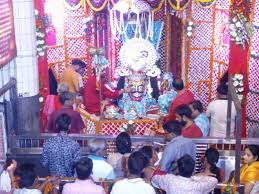Agra : This year’s Taj Mahotsav has given a big boost to spiritual tourism, which could bring more footfalls and make tourism everybody’s business.
The high voltage and spectacular daily Yamuna Aarti, an event organised by the Agra Municipal Corporation, has been drawing thousands of people.
A series of cultural activities are being organised in different parts of the city to highlight the importance of Hindu temples.
The Yogi Adityanath government has changed the name of a metro rail station to Sri Mankameshwar. Earlier it was Jama Masjid station.
Meanwhile, hoteliers, guides, green activists who joined the symposium on Agra beyond the Taj, demanded recognition of Agra as a heritage city with rich Hindu cultural traditions and relics.
If Tamil Nadu could be known as the ‘Temple State of India’ and Bhubaneshwar as the ‘Temple City of India’, Agra too can be described as the hub of Shiva temples.
Not many people know that Agra is not just a grand Mughal city, but its antiquity is also defined by a string of centuries-old Shiva temples, which rightly give it a new profile as Shiva’s own land.
In fact many people believe that the Taj Mahal itself was a Rajput Shiva temple.
A simple search on Google Maps will show hundreds of Shiv temples in Agra district, which is part of Braj Mandal, the land of Shri Krishna.
In a move to present a new profile of Agra and raise awareness on this, SPHEEHA (Society for Preservation of Health Environment and Ecology and Heritage of Agra) in partnership with Tourism Guild of Agra and Uttar Pradesh Tourism organised the fourteenth edition of its annual event, ‘Agra Beyond Taj’ to deliberate about the ‘Chronology of Shiv Temples in Agra and Bateshwar’ as part of the ongoing Taj Mahotsav.
The high priest of Shri Mankameshwar temple, Mahant Yogesh Puri, outlined the history of Agra.
He claimed that the Shri Mankameshwar Temple of Agra, was over 5,500-years-old and the 28th generation descendant of the family was serving Lord Shiva in the temple.
Puri said Agra was indeed the ‘City of Lord Shiva’. His conviction stems from the fact that Agra has four famous Shiva temples at the four entrances of the city as well as four famous temples dedicated to Lord Bhairav (widely believed to be the eighth form of Shiva, whereas some believe Bhairav as a child of Shiva).
Agra also has two prominent Shiva temples, which have an ageless history associated with these temples. Hence, Agra can be and should be developed as a spiritual tourism centre with well-defined itineraries and facilities.
Former President of the Tourism Guild of Agra, Arun Dang, highlighted the fact that Mahadji Scindia and Ahilyabai Holkar helped resurrect many Shiva Temples in Agra and Bateshwar famous for its 101 Shiva temples in a row, along the bend of river Yamuna, during the heydays of the Maratha empire from 1758 to 1818. Even the renowned poet, Nazeer Akbarabadi has mentioned the role Shiva temples played in shaping the character of Agra, in his numerous poems.
Pankaj Gupta, Secretary of SPHEEHA, spoke on spiritualism and environmental consciousness, making a profound statement that the current climate change crisis also required a spiritual response comprising physical and meta-physical activities determined by five elements so that all living beings can flourish.
In this regard he focused on the river cleaning activity being done at Poiyya Ghat by SPHEEHA in association with DEI University and the Radhasoami Satsang Sabha as well as the inclusions of camels in the barns of Dayalbagh celebrating the ‘Year of Camelids’ as declared by United Nations.
Anu Dhillon Singh of Mela Kothi and Chambal Safari showcased a presentation of various temples of Bateshwar with their brief history. Shyam Kumar from Double Tree by Hilton stressed on the role tourism played in boosting the local economy, and the need of laws governing tourist behaviour and improvement of basic facilities in the city.
Academic Shabd Mishra hoped that in future the city of the Taj would also be recognised as the hub of Shiva Bhakti, and the hundreds of Shiva temples with their unique history, would be given a makeover to attract spiritually-inclined tourists.






Related Posts
Crucial day for AAP and CM Kejriwal as cases come up for hearing in SC, HC
Yogi govt releases funds for upkeep of stray cattle
UP Cong chief Ajay Rai to file nomination for Varanasi LS seat on May 10